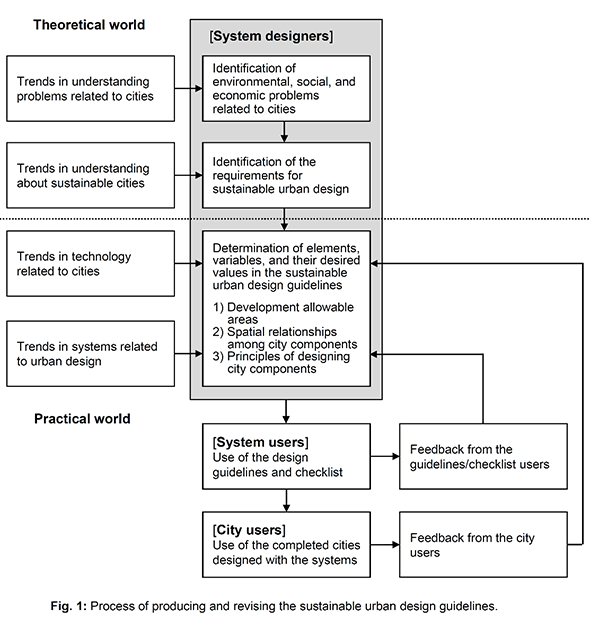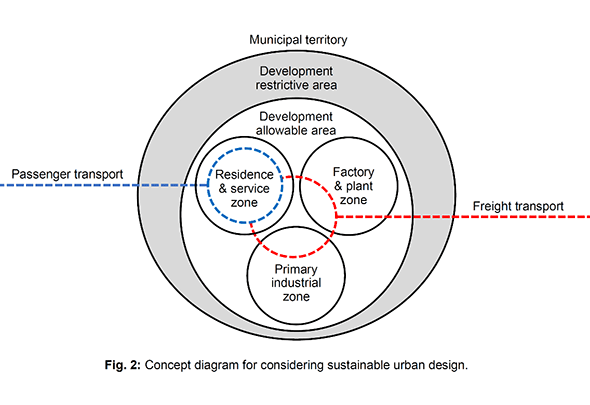Institute of Environmentology, Research and Education for Sustainability or Sustainable Development, Kazutoshi Fujihira
Sustainable City Research
Institute of Environmentology >> Sustainable City Research
Sustainable City Research
Utilizing the methods built up through the sustainable housing research, we have been progressing in studies on "sustainable cities."
The production and revision process of "sustainable urban design guidelines" is illustrated in Fig 1. The central part demonstrates the course of preparing and using the design guidelines. First, system designers produce or revise the sustainable urban design guidelines through the three-stage process. They also prepare "sustainability checklist," based on the design guidelines. Next, system users employ the design guidelines and checklist. Finally, city users utilize the completed cities designed with these systems.
The four blocks on the left show the items to check when producing or revising the design guidelines. Meanwhile, the two blocks on the lower right show the items to check when revising the design guidelines, based on the feedback from the system users and city users.

The process of producing the sustainable urban design guidelines consists of three stages: (1) identification of environmental, social, and economic problems related to cities, (2) identification of the requirements for sustainable urban design, (3) determination of elements, variables, and their desired values in the sustainable urban design guidelines.
1. Environmental, social, and economic problems related to cities
Observing trends in understanding city-related problems, system designers identify environmental, social, and economic problems related to cities. City-related problems generally include urban sprawl, environmental destruction, biodiversity loss, waste, traffic congestion, environmental pollution, global warming, climate change, damage caused by natural disasters, sluggish economy, and crimes.
2. Requirements for sustainable urban design
In the second stage, based on the selected city-related problems, system designers identify the requirements for sustainable urban design. For instance, if "traffic congestion" is identified as a problem in the first stage, "shifts from automobile to mass transit, and walking and biking" can be specified as the requirement.
3. Elements, variables, and desired values in the sustainable urban design guidelines
In the third stage, the requirements for sustainable urban design are converted into the framework of "element-variable-desired value," which can be found in the design guidelines. This conversion helps system users to speed their understanding of what should be designed and the courses of design.
Unlike the design of city components, such as buildings, designing the whole city needs extensive spatial planning. Therefore, the third stage of producing sustainable urban design guidelines consists of three steps: (1) development allowable areas, (2) spatial relationships among city components, (3) principles of designing city components.
(1) Development allowable areas
The first step focuses on the relationship between land development and natural features. As demonstrated in Fig. 2, a municipal territory can be divided into development restrictive areas and development allowable areas. "Development allowable areas" mean areas where land development can be permitted.

At first, we have identified "development allowable areas" as the element of the first part of the sustainable urban design guidelines. Next, we have determined its three variables: "biodiversity," "natural disaster risk," and "topographic gradient." When defining "development allowable areas," it is necessary to select areas where all these three variables meet their desired values. In other words, areas contributing more to biodiversity, natural disaster high-risk areas, and steep-sloping areas should be excluded from development allowable areas. In addition, the way of defining development allowable areas and development allowable areas is explained in detail in the webpage of Sustainable Land Development.
(2) Spatial relationships among city components
The second step focuses on the placement of land development sites and facilities. Land development sites need to be located in development allowable areas. As demonstrated in Fig. 2, land development sites can be divided into three main zones: (a) residence and service zone, (b) factory and plant zone, (c) primary industrial zone. The "residence and service zone" contains facilities for people's use, including houses, buildings for various services, streets, and parks. The "factory and plant zone" includes facilities for large-scale industrial production, such as manufacturing factories and power plants. The "primary industrial zone" contains farmlands and planted forests. Besides, facilities for interurban and local transport are important as city components. Thus, we have also drawn typical transport routes into Fig. 2, dividing them into passenger transport and freight transport.
On the basis of the above placement concept, spatial relationships among city components are shown as the second part of the design guidelines. First, the three main zones and significant types of facilities are selected as elements. Next, variables and their desired values are determined so that the requirements for sustainable urban design can be satisfied. To cite "residence and service zones" as an element: the "extent of the zone from a passenger transport station" and "within walking distance" can be specified as the key variable and its desired value, respectively.
(3) Principles of designing city components
Step 3 shows the principles of designing city components. First of all, significant city component types are identified as elements. After that, items that strongly influence urban sustainability are specified as variables. Moreover, their desired values are also determined. To cite "residential streets" as an element: "passage" and "pedestrians, bicycles, and vehicles for the residents" can be identified as the key variable and its desired value, respectively.
Related publications
How to Design Sustainable Structures
Fujihira K. IntechOpen; 2020. DOI: 10.5772/intechopen.95012
